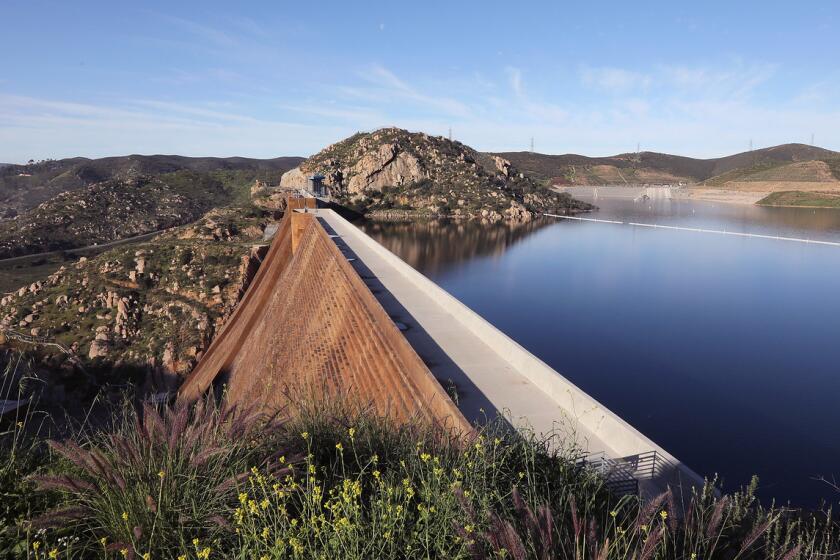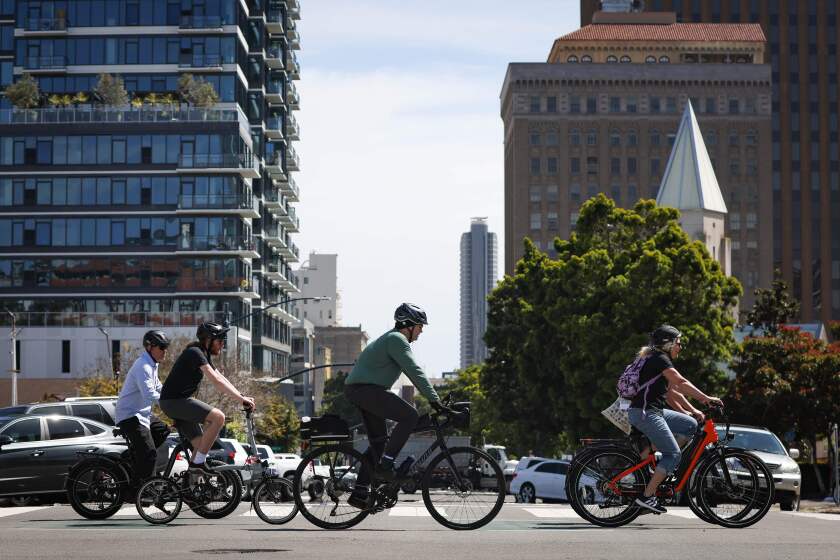Encinitas agrees to continue funding for temporary restrooms
Encinitas will keep the temporary, portable restrooms it put in months ago to help combat a hepatitis A outbreak, though the regional health crisis that led to their installation has subsided.
In the coming fiscal year, the city also will fund two new freeway underpass art projects and conduct extra power washing of downtown’s sidewalks, the City Council agreed in a special meeting Wednesday, June 13.
The votes on the art and sidewalk spending items were unanimous, while the council divided on the Porta-Potties, voting 4-1, with Councilman Mark Muir opposed, to keep them in place for another year.
“To me, the fact that the hepatitis A outbreak happened is a symptom of a problem,” Mayor Catherine Blakespear said, adding that the region’s homeless problem hasn’t vanished and that’s why she would support leaving the portable restrooms in place. “If anything, I think we should consider expanding it.”
Hepatitis A causes a highly contagious liver infection. It spreads when people come in contact with fecal material and many of its victims during the recent regional outbreak were homeless people who lacked access to bathroom facilities.
As of June 6, the county’s Health and Human Services Agency reported that there were 589 cases of hepatitis A and 20 deaths since the county’s outbreak began. Five of the cases were in Encinitas, and four of them were reported after Jan. 1, city officials said.
During the June 13 council meeting, Councilwoman Tasha Boerner-Horvath noted that the hepatitis A outbreak situation had eased up somewhat in recent months — San Diego County ended its “local health emergency” status in late January — but said the need for publicly accessible, 24-hour bathrooms and hand-washing stations still remains.
Councilman Tony Kranz said he supported having the restrooms, but wished the plastic structures looked nicer.
“They just have this feel of impermanence that a city like ours should be trying to avoid,” Kranz said, adding that he wished the city would build decorative structures around the temporary buildings to screen them from view.
Muir, the lone vote against the proposal, said he, too, was concerned about the plastic structures’ appearance and thought the city should explore other options for dealing with the bathroom situation.
Blakespear said one solution the city has been advised not to pursue is leaving its permanent restroom buildings — ones in parks and other city facilities — open 24 hours a day because vandalism to those structures is much more costly to repair than damage to the plastic structures.
Council members did agree June 13 to ask city staff members to look into leaving one permanent facility at Moonlight Beach open 24 hours a day, saying there is a high police presence in the area and that would deter would-be vandals.
Encinitas installed portable restrooms and separate hand-washing stations in six locations last fall -- City Hall’s lower parking lot on Vulcan Avenue, a spot adjacent to the 7-11 at Vulcan Avenue and Leucadia Boulevard, the Grandview overlook, Swami’s Beach and Moonlight Beach.
Continuing to operate the portable restrooms is expected to cost the city $20,900 in the coming fiscal year, which begins July 1, a city staff report states.
The restroom funding was one of several items the council agreed to add into the coming year’s spending plan.
Council members also agreed to include $192,567 for public art displays on the Santa Fe Drive and Encinitas Boulevard freeway underpasses. Much of the money — $155,467— would go for the Encinitas Boulevard project, which consists of a 3-foot-wide decorative ribbon of mosaic work running along the walls approaching the underpass.
The council also agreed to add $118,193 for additional sidewalk cleaning services for the downtown, particularly during the busy summer months.
Encinitas uses a two-year budgeting system, approving two years’ worth of spending plans one year and updating as needed before the start of the second year. This coming fiscal year is the second in the city’s latest two-year cycle.
As currently proposed, the city’s general fund budget — the budget covering most day-to-day expenditures — now calls for revenue in the coming fiscal year to be $74.4 million and expenses to be $65.87 million. That’s a $1.2 million increase in revenue from what was originally forecast for the coming fiscal year and a $1.1 million increase in expenditures, Tom Gallup, the city’s finance director said.
The current fiscal year’s spending plan calls for revenue to total $71.6 million and expenses to total $64.6 million, while in the previous fiscal year, revenue was $69.4 million and expenses were $56.7 million.
-- Barbara Henry is a freelance reporter for The San Diego Union-Tribune.
Sign up for the Encinitas Advocate newsletter
Top stories from Encinitas every Friday for free.
You may occasionally receive promotional content from the Encinitas Advocate.




